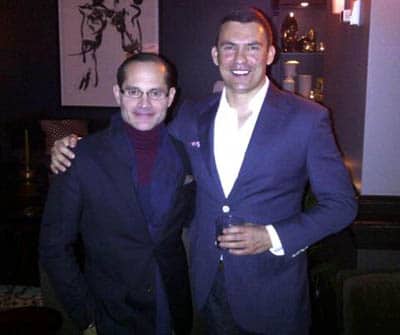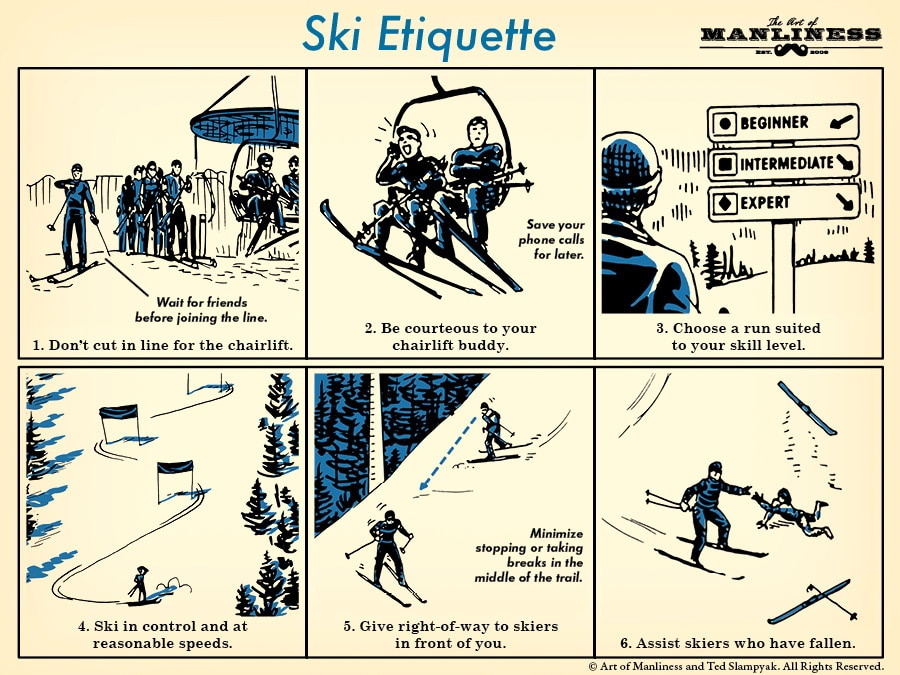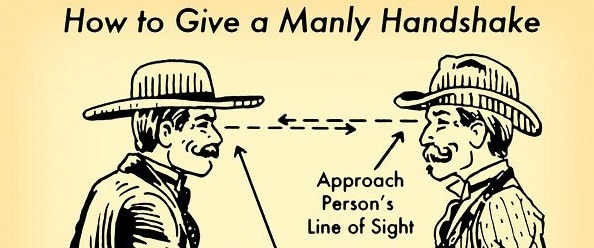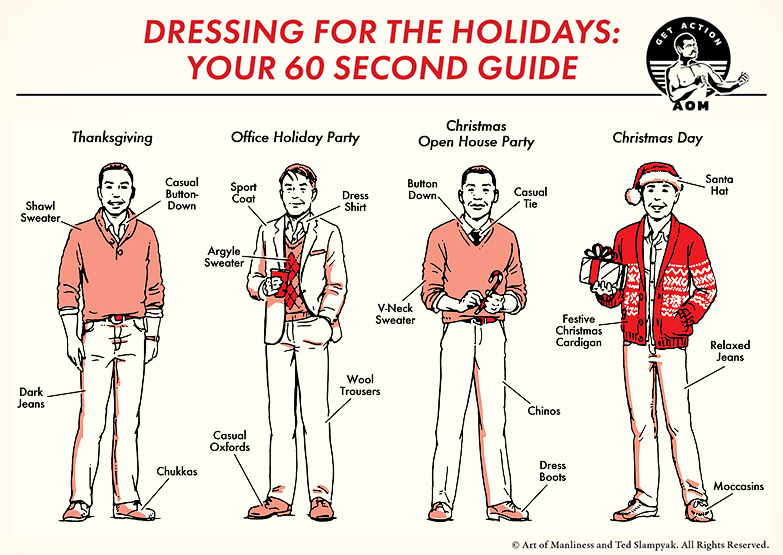
Last month I was invited to attend a whisky-tasting event in Chicago hosted by Chivas Regal. As part of their Chivas Brotherhood, they have an 1801 Club in which members get access to exclusive, invite-only events at private venues in major US cities. I had the privilege of checking one out and hob-knobbing with a bunch of folks I had never met before.
Now, despite the fact I write about style and own a custom clothier, I rarely go out and socialize. Being a father of three young children and living in a small Wisconsin town…well, it just doesn’t happen.
To put it bluntly – I really had to prepare for this!
This article is based off my experience and lays out the steps I took to ensure my time spent out on the town was worthwhile.
Here’s the scenario: You’re in a large city, heading to an upscale evening social event. You’re attending the event alone, and you know no one prior to arriving. There is alcohol being served, yet you will be speaking with people about business opportunities.
This is my advice on how to prepare for a night of networking and socializing, and how to make the most of this opportunity. In order to bring all the information together in one place, and create a comprehensive guide, I’ve included new information we haven’t covered before, a review of some important things that we have, and links to past articles for those who want more details on a specific subject. Hope you find it helpful.
Before You Go: Basic Logistics
Any Boy Scout knows you should always be prepared. That goes double when you’re traveling. It’s not just a sensible safety precaution, it’s also part of your good impression — being able to show up on time, get yourself back safely, and even provide directions or a ride if someone else needs it. This immediately makes you look like the guy everyone wants to know.
With that in mind, here are some basic steps to review before you depart:
1. Know Where You’re Going
This one should be fairly obvious, but know where you’re meeting people. With Google maps, there is no excuse for not quickly verifying the address you have and calling the establishment to ensure they are where they say they are and are open when you plan to arrive. You do not want to arrive at the event 10 minutes early only to find you mistakenly wrote down the wrong address and now have to travel back across town.
The address is the starting point, and here are a few other details you may need to know depending on what sort of event you’re attending:
- Parking options (valet, parking ramp in the building, separate garage, street parking, etc.)
- Public transit options (check for nearby bus and train lines)
- One-way streets (know about ’em BEFORE you end up circling the block)
- Opening/closing hours if relevant
If you think the event will wrap up reasonably early and there’s a chance you might want to continue socializing afterward, also check for other venues like restaurants and bars in the immediate vicinity.
There’s a lot of power in being able to say, “Well, if we want to keep talking about this over drinks, I know a decent little bar around the corner.”
2. Know How You’re Getting Home
This is almost as important as getting there — and can be harder, since options tend to dwindle as the night wears on.
Have a plan for getting yourself back to wherever you’re staying, and have a plan with some flexibility in case the night takes an unexpected turn. It’s good to have as many resources on hand as possible:
- Cars: If you have your own car, that takes care of most of the thinking most of the time. You need to know where you can park it, and for how long, but as long as you can sort that out you’re pretty well taken care of. Just watch how much you drink!
- Cabs: No matter how you’re getting there (even if you’re driving), it’s never a bad idea to have the number of a local, licensed cab company written down in your wallet or programmed into your phone. Pick one that dispatches 24/7 so that you always have an emergency option.
- Public transit: Often the cheapest way of getting around a city, it’s also the trickiest for non-natives. Look up the route information online, rather than relying on brochures or bus stop postings — those tend to be outdated and may not list the correct times. Be aware that most routes do not run 24/7, and those that do usually run less frequently late at night.
- Walking: It’s severely underrated, but often the easiest way to get around a city, so long as you’re not going too far. Just have a good sense of safety and don’t walk anywhere too deserted or dicey-looking at night, especially if you’re well-dressed.
A little preparation goes a long way here, and smartphones make it even easier (as long as you can get service). Be sure to have both the city’s public transit schedule or map and the number of a cab company at bare minimum. It’s rare that you won’t be able to get yourself around using those in a pinch.
3. Know the Environment
Both the physical and the social environment are important here. Both help determine how you’ll dress and how you’ll travel.
In New York, wearing a stylish suit and taking the subway makes total sense. In Denver the suit is overkill and you can probably walk everywhere, at least downtown. In Los Angeles, you won’t wear a tie, and you’ll probably have to drive. And so on.
There are three basic factors to consider when traveling to a new city:
- Weather: This determines what you’ll pack in terms of outwear, rain protection, and so on. Don’t show up to Seattle without an umbrella, and don’t show up to Houston with one!
- Culture: This can be hard to judge, but in general, large cities (and the East Coast as a whole) tend to be dressier and put more emphasis on style. Smaller cities, especially ones that are big convention hubs, tend to have more conservative, business-oriented styles, and the West Coast is famously casual.
- Distances: If you’re staying in a little resort town and not going more than five blocks from your hotel, you can dress more adventurously than if you’re staying in downtown New York and meeting people all over the city; if you find yourself dressed inappropriately, you can simply abscond to your hotel, change, and return with no one knowing.
All of these are common-sense decisions that you make before you go. But they’re decisions that make a big difference in how natural and comfortable you look when you arrive at your event.
Be sure to listen to our podcast on better networking:
Networking Preparation: How to Be Ready for Success
Making a good impression is nine-tenths being ready to make a good impression. The rest is just acting natural.
You want to show up to any kind of social event (even one that isn’t specifically billed as a networking or meet-and-greet event) with the basic supplies and preparations that will make a good impression and get your contact information out there:
1. Know Who Will Be There
Have as good a sense of the guest list as you can. Check to see who is on the e-mails or website or just ask around if it’s a more casual, word-of-mouth affair.
Once you know who is going to be there, do some research if you don’t know them all that well. You’ll want to know who is representing what companies, and what that company has been in the news for lately — people are always very impressed when you can say, “I saw your latest project in the news last month,” or something to that effect.
For my Chicago whisky-tasting event – I managed to get an early look at who the evening’s special guests were. Turns out one of my favorite men’s style authors, Tom Julian, was going to be in attendance. I had reviewed one of his books over a year ago, and pulled up the thank you he had sent me and sent him a quick message just mentioning I would be in attendance. Sure enough, we ran into each other and were able to meet in person. See the picture below for proof!
A good sense of the guest list gives you the ability to plan your small talk. Know what’s going to be of interest to the other people there, and plan on saying it. For a refresher on networking in general – make sure to visit this classic Art of Manliness article.
2. Carry Business Cards — Plenty of Them
Bring more than you think you’ll need. The only thing worse than not having a card at all is saying, “Here, let me give you my card,” and then coming up empty-handed.
Most men’s wallets can only accommodate five or ten spare business cards before the pockets start to get a little stretched, so don’t be shy about keeping an extra stack in an inside jacket pocket. Or, slip them in a small, silver card case or cigarette case, giving you a small, classy touch every time you reach for a card.
Have a business card that suits your professional needs:
- Always include your personal name, even on a company card.
- Have your personal number on the card, not a general phone line.
- Spring for heavy stock — the cheapest cards are recognizable as such.
- Avoid extensive graphic designs. Keep it simple.
Of course, men in specific industries may need something fancier — if you’re a graphic designer, you may want to use a card you’ve designed as an example of your work. Just be aware that it’s easy to cross the line from “unique” into “novelty,” and that the latter isn’t impressive.
No need for business cards? Consider calling cards instead.
3. Carry a Pen. In Fact, Carry Two.
Asking to borrow a pen is automatically unprofessional. Carry two, either in the inside breast pocket of a jacket if you’re wearing one, or in the side pocket of your trousers. Go ahead and slip them all the way in, especially if you’re keeping them in an outer pocket — the clips on the side of the cap shouldn’t be visible outside your pocket.
It’s not necessary to spring for a $100 fountain pen (though if you have something like a Montblanc, go ahead and make use of it!), but avoid carrying anything that’s obviously cheap, like a bendy, plastic Bic or a hotel freebie. You can get away with plastic, but it should be plain, dark plastic without any obvious logos on it.
Ideally, shell out for metal-cased ballpoints at the very least. You can get them from office supply stores for under $20, or you can buy a nicer one from a brand like Fischer online, and the difference they make in your first impression is significant.
You carry two, obviously, in case one runs out of ink (or gets misplaced). Again, it’s all about avoiding awkward moments. Similarly, keep them tip-down in your pocket if they’re ballpoints (unless it’s a space pen, of course) so that you don’t have to make a bunch of little circles to get the ink flowing before you write.
4. Silence Your Cell Phone — And Check It in Private
Cell phone etiquette is not an esoteric question anymore. Almost everyone has one, and you don’t want to be seen as being “one of those cell phone guys” who is always flicking away at the iPhone screen.
- Keep the phone on silent, or at least on vibrate, and use it as little as possible:
- Don’t check or answer the phone while in conversation, even if it buzzes.
- Excuse yourself to someplace private to make a call.
- Wait until after the event to text or check news/scores, unless urgent.
- Use the phone for urgent business only. Don’t check e-mail or games!
There’s nothing wrong with using the phone if you have to, so long as you do it discreetly — just limit yourself to actual needs. Unless you’re counted on for round-the-clock instant access, letting your texts and e-mails go unanswered for a few hours should not be the end of the world.
Personal Presentation: How to Dress and Behave for Success
There are whole books written on dressing for business and for social occasions, but it all comes down to a couple basic principles: looking neat, looking appropriate for the occasion, and behaving politely.
1. Look Neat
“Neat” is a deliberately broad term here. It means that no matter what standard of dress you’re at or what culture you’re in, you look well put-together and like you’ve paid attention to details.
This is fairly easy to achieve, whether you’re wearing a suit and tie or just jeans and a work shirt. It’s more a matter of avoiding obvious mistakes than doing any extra steps:
- Wear clean clothes that match well — no clashing colors, wrinkles, or stains.
- Shine shoes and press shirts ahead of time for a crisper look.
- Get a trim if you haven’t had a haircut recently.
- Trim your nails and wash your face before going out.
- Add a bit of cologne if you like, but keep it light and mild-scented.
- Add a pocket square if you wear a jacket.
- Wear a dress watch (leather or metal band; metal case).
- Shower a few hours ahead of time, with enough time for your hair to dry.
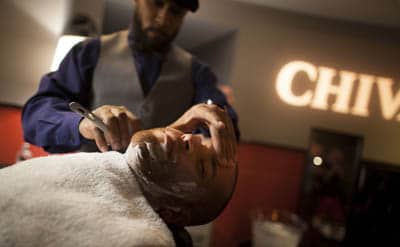
The whisky-tasting event I attended had master barber Charles Lennox of Haberdash Men on location giving demonstrations!
These are minor details that make a major difference. Putting them all together is what gives you the sharp-edged, clean-cut look that a lot of men lack in their day-to-day lives. It’s a way of looking good that doesn’t show off or try too hard, and gives you the air of casual competence and confidence you need to network well.
2. Dress Appropriately for the Occasion
Most evening social events aren’t officially business affairs, even if business is being done at them. That usually means you’re wearing something more casual than a business suit, and most people also observe the “no ties after 5:00 PM” guideline unless they’re going somewhere very fancy.
If that sounds a little open-ended and hard to dress for, that’s because it can be. The best outfit for an evening out is one that is classic, simple, and a touch conservative, but relaxed enough that it’s clearly not something you could wear to work. There are a few good ways to achieve that:
- Wear a jacket. A casual blazer or sports jacket looks much nicer than a shirt on its own. You don’t need a very severe jacket, unless you’re going somewhere very upscale and conservative, but just a cotton sports jacket or a light wool blazer will take you from “acceptable” to “sharp.”
- Casual suits are another option, but one that takes some caution — you don’t want to look like you just wore a business suit without the tie. If you have a light-colored or casually-patterned suit, wear it with a colored shirt and some casual shoes to de-emphasize the formality.
- Shirts for the evening should usually have a little color or pattern to them. If you do wear a plain white one, frame it with a patterned jacket or something like a cardigan sweater that has a visible texture of its own.
- Slacks or chinos are often sharper-looking than jeans, but if it’s a very casual setting, like a pub, don’t be afraid to wear dark, fitted jeans.
- Leather shoes are your best-looking option, but you can also go with casual shoes with some decorative patterning on them. Brogues, saddle shoes, and wingtips all work well, as do loafers and in some casual settings leather work shoes. For very dressy restaurants or shows, you’ll need black oxfords, but they’re the exception rather than the rule.
The key is really just to know expectations: at a pub, jeans and a corduroy jacket is dressed up. At a private gala with live orchestration, you need a suit. Most things fall in between, and when in doubt your best bet is usually good slacks, leather shoes, and a collared shirt with a sport coat or blazer.
And if you simply need some general guidelines on dressing for different occasions, check out this handy 60 Second Guide.

3. Behave Politely
This is part etiquette and part appearance, and sort of bridges the gap between the two. You want to look like a positive addition to the room — someone whose presence is making other people’s lives better. For a basic etiquette reminder – visit this classic AOM article.
You can easily achieve this by simply being helpful and reaching out to others. Smile, be polite, and offer help where it’s needed, especially in small gestures and motions:
- Help to hold doors and pull chairs out for others.
- Offer your seat if someone needs it.
- Help to make room at a crowded bar, or to order for someone if needed.
- Always offer a firm handshake when meeting someone.
- Make eye contact.
- Avoid having more than a few drinks — it’s more noticeable than you think!
- Offer a lift if you have a car and someone needs one (within reason).
By being helpful and polite as you circulate, you aren’t just making a good impression on the people you’re speaking to, you’re also making a visible impression on the rest of the room. That helps set up the expectation that everyone will enjoy your company — and make everyone more likely to automatically smile when you reach them.
How to Circulate: The Art of Small Talk
“Diplomacy is merely the extension of war by other means,” and small talk is often just business in a more relaxed set of clothes. Expect to do a bit of work even when you’re mingling.
1. Arrive Early
This will make the mingling easy on you — it’s much harder to introduce yourself when people have already arrived and formed casual circles of their own.
It also gives you a chance to meet and greet everyone in person, rather than having to try and remember the names of five or six people at once when you join a new group.
If you get there early, make a point of circling the room once to greet everyone that’s already there — including and especially the people who haven’t seemed to find groups of their own yet. You’ll be in the good position of “knowing” everyone there by the time the bulk of the guests arrive.
2. Mingle Actively
You don’t want to be one of the people standing and hoping for someone more aggressive to come talk to you. Go ahead and seek people out.
Someone on their own is always fair game. All you have to do is walk up, smile and offer your hand, and say “I’m [name], and I thought I’d come introduce myself. What brings you here tonight?”
The phrasing can vary somewhat, obviously, but a simple introduction is always an appropriate start. You don’t need an “excuse” to make it — just being at the event is an excuse. Meeting people is part of what everyone is there for. For more extremely helpful tips on how to initiate small talk and build it into a conversation, see this indispensable AoM guide.,
Introducing yourself to people in groups is a little harder, but still acceptable. Find an open space, move slowly in, and smile. Then wait for a pause in the conversation and say, “I’m sorry, I overheard you talking and thought I’d join in. My name’s [name].” Once again, offer a handshake, this time to everyone in turn, and then say, “Sorry to interrupt — you were saying?” or a similar prompt.
In the case of large groups (four or more), it’s acceptable to approach someone on the fringe and break them off for a separate conversation. Just make sure they’re not deeply involved in another conversation when you do it.
If you need to get out of a conversation, or just want to move on to meet more people, you can always excuse yourself to use the restroom, get a drink, or greet a friend that you know.
3. Learn Names — And Use Them
One of the best impressions you can make on someone is to use their name. We don’t necessarily realize how rarely people do it, but in most social settings people use eye contact and body language to indicate who they’re talking to, rather than referring to people by name.
Using someone’s name gives you a more personal connection and prompts them to pay attention to what you’re saying — and, more fundamentally, it shows that you’ve bothered to learn their name in the first place.
Not all of us are blessed with perfect memories, so if you struggle with names adopt a strategy to help you remember:
- Use it or lose it. As soon as you’ve been introduced, try to use the person’s name. That helps make an immediate association that lasts longer than just hearing it.
- Memory by association. This is an old mnemonic trick with lots of variations. When you learn the name, say it aloud, and associate it internally with some other fact that starts with the same letter. It’s particularly helpful if you can use something you know about the person: “Nick from Northwestern,” or “Allison who works in Accounting,” and so on.
- When in doubt, take notes. You need a bit of subtlety to pull it off, but if it’s really important that you remember someone’s name, find an excuse to write it down. You can note it on one of your own business cards and tuck it in a pocket separate from the rest — just be sure not to accidentally give it to someone. Alternatively, ask if they have a card themselves. That gives you both the name and a unique graphic to remind you whose it is.
You become particularly impressive when you’ve met someone, moved away from them, circulated for a while, and then come back and immediately greet them by name. Most people at any given event can’t do that, so you’re sure to stand out for it. For more strategies on remembering names – visit this classic AOM article.
Follow-Up: After the Event
The day after the event is the time to follow up on any contacts you’ve made. Resist the urge to send any sort of follow-up the same night — that can seem either overeager or pushy, or both. Give it until mid-morning the next day.
There are a few follow-ups you should always send:
- A note to the host, if relevant. Not all social gatherings have a specific host, but if there is one, send him or her a note. Either a short, well-written e-mail (with a proper salutation and full sentences, not internet shorthand) or a handwritten note by mail is appropriate. In either case, it should go out within 48 hours. If you take longer than that, still send the note, but include a line to the effect of, “Sorry it took me so long to get back to you.”
- A short note to anyone who gave you their contact info. Usually, someone who hands you a card or gives you their information is inviting a follow-up. Even if you don’t have specific business in mind, shoot them a short e-mail that says, “It was good to meet you last night. Let me know if I can ever do anything for you!” That leaves the door open for them to pursue the relationship or not, as they desire.
- A longer, specific letter to anyone you’re hoping to do business with. This could also apply to people you want to pursue a purely social relationship with — in either case, send an e-mail the next day offering to discuss things with them further, or (if you were given a phone number) give them a call. Say that you appreciated meeting them, and that you’d like to chat more if there’s a time that’s convenient.
For a great reminder on how to write an effective email – visit this classic AOM article.
Something won’t always come of it. Many contacts never get around to replying, either because they were too busy, they weren’t interested, or they just felt too awkward to reply. But it’s through no fault of yours at that point — and you’ll be out there again at the next event, collecting a new set of contacts, and expanding your personal network even further.
_________________________
I would like to thank my fellow Chivas whisky tasting attendees Armando over at AskMen.com and George over at Zaharoff Menswear for the photos!
Written by Antonio Centeno
Author of the internet’s best free style ebook.


